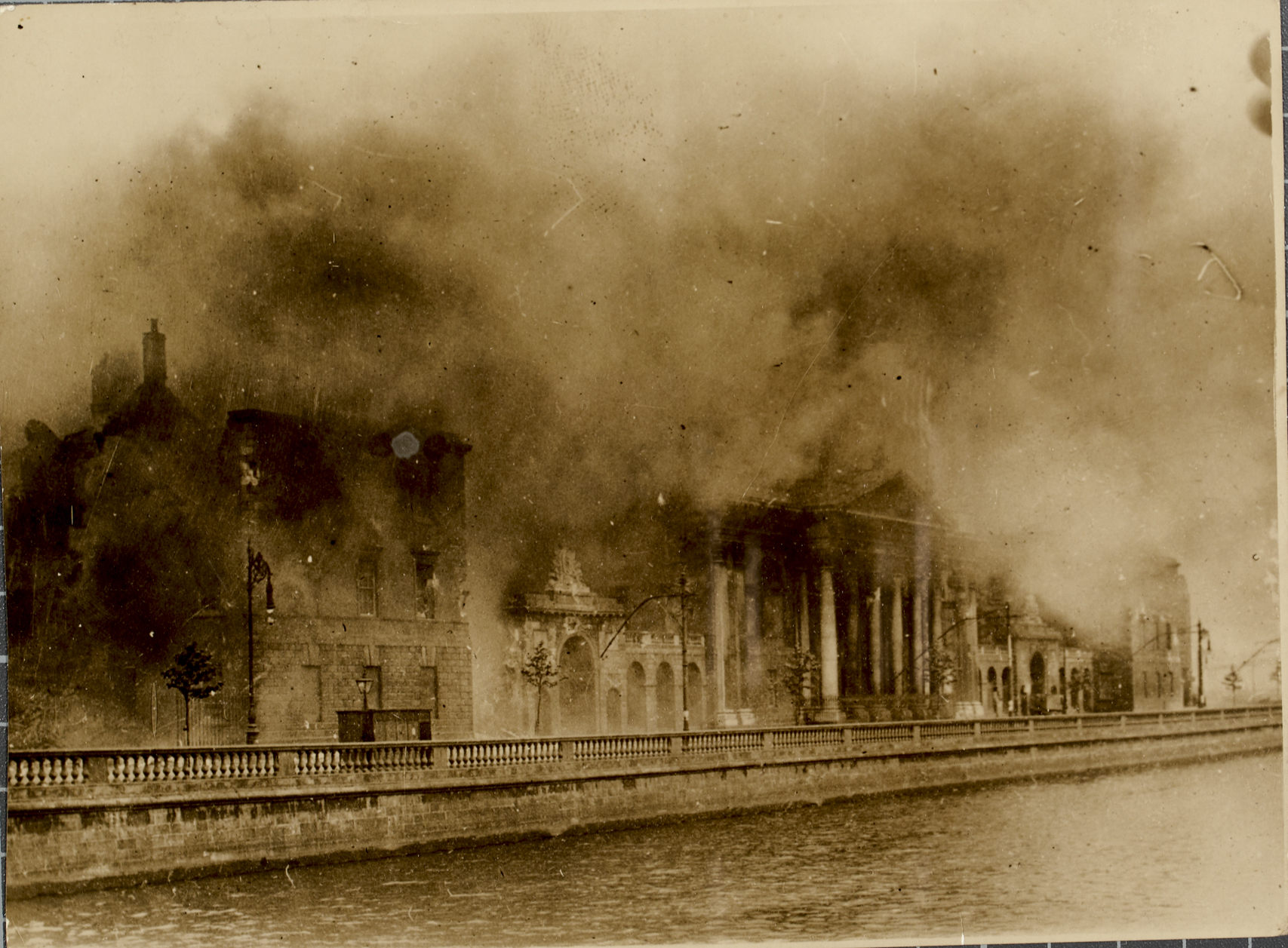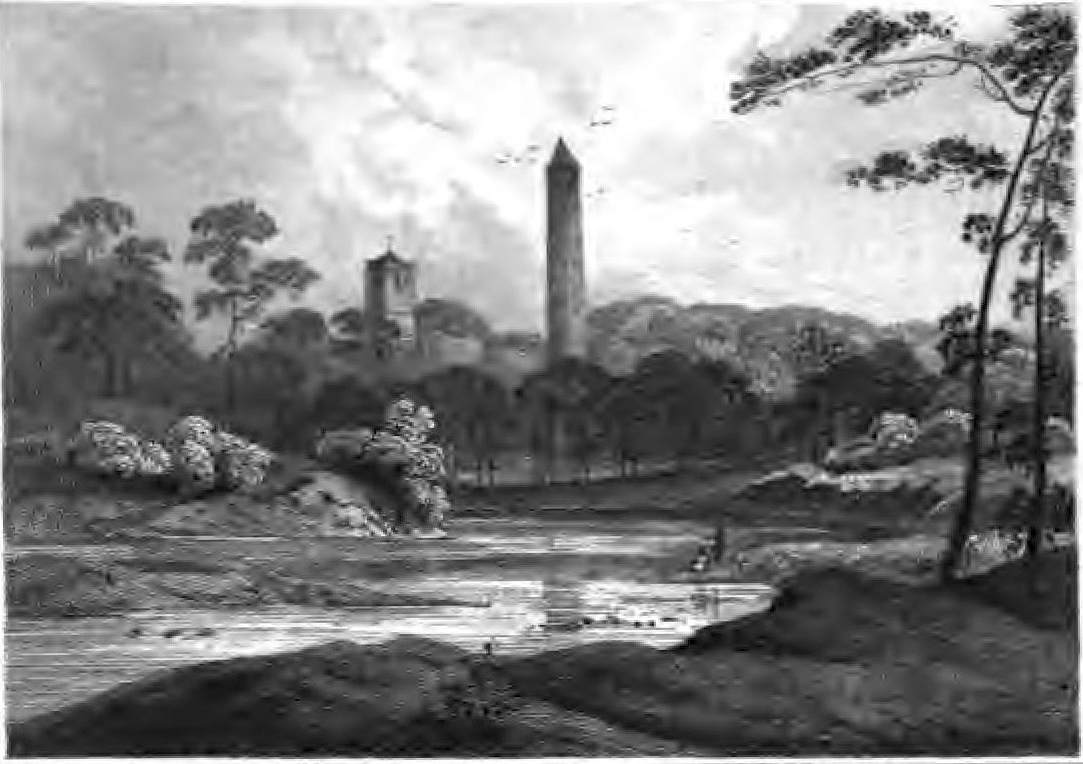|
Thomas Joseph Byrne
Thomas Joseph Byrne (15 November 1876 – 27 January 1939) was an English architect, and was principal architect to the Office of Public Works in Ireland who oversaw the restoration of a large number of public buildings in Dublin following the Easter Rising, the Irish War of Independence and the Irish Civil War. Early life and family Thomas Joseph Byrne was born in Kingston upon Thames, Surrey on 15 November 1876. His father, Richard Byrne (died c. 1876), was from Muine Bheag, Bagnelstown, County Carlow, and served with the Royal Irish Fusiliers. His mother, Harriet Byrne (née Knight), was English. On 29 August 1901, he married Mary Ellen Scott, elder daughter of Anthony Scott at the St Mary's Pro-Cathedral, Pro-Cathedral in Dublin. They had at least two daughters and two sons. Both of their sons, Niall C. and T. Brendan, became engineers, and his daughter, Ethna Byrne-Costigan, Ethna, was a lecturer in Romance languages at University College Cork. Bryne was interested in mechani ... [...More Info...] [...Related Items...] OR: [Wikipedia] [Google] [Baidu] |
Office Of Public Works
The Office of Public Works (OPW) ( ga, Oifig na nOibreacha Poiblí) (legally the Commissioners of Public Works in Ireland) is a major Irish Government agency, which manages most of the Irish State's property portfolio, including hundreds of owned and rented Government offices and police properties, oversees National Monuments and directly manages some heritage properties, and is the lead State engineering agency, with a special focus on flood risk management. It lies within the remit of the Minister for Public Expenditure and Reform, with functions largely delegated to a Minister of State at the Department of Public Expenditure and Reform with special responsibility for the Office. The OPW has a central role in driving the Government's property asset management reform process, both in respect of its own portfolio and that of the wider public service. The agency was initially known as Board of Works, a title inherited from a preceding body, and this term is still sometimes e ... [...More Info...] [...Related Items...] OR: [Wikipedia] [Google] [Baidu] |
Anthony Scott (architect)
Tony Scott (1944–2012) was a British film director. Tony or Anthony Scott may also refer to: Entertainment * Tony Scott (musician) (1921–2007), American jazz clarinetist * Tony Scott (rapper) (born 1971), Dutch rapper * A. O. Scott (born 1966), American film critic Sports * Tony Scott (baseball) (1951–2024), American professional baseball player * Tony Scott (footballer) (1941–2021), English professional footballer * Tony Scott (American football) (born 1976), American footballer * Anthony Scott (footballer) (born 1995), Australian rules footballer for the Western Bulldogs Other * Tony Scott (physicist) John Anthony "Tony" Scott is an Irish physicist and science communicator. He co-founded with Tom Burke (his former teacher in Terenure College) the Young Scientist and Technology Exhibition in 1963. He studied physics at University College ..., Irish physicist and science communicator * Tony Scott, CIO of the US federal government 2015–2017 {{hndis, ... [...More Info...] [...Related Items...] OR: [Wikipedia] [Google] [Baidu] |
Four Courts
The Four Courts ( ga, Na Ceithre Cúirteanna) is Ireland's most prominent courts building, located on Inns Quay in Dublin. The Four Courts is the principal seat of the Supreme Court, the Court of Appeal, the High Court and the Dublin Circuit Court. Until 2010 the building also housed the Central Criminal Court; this is now located in the Criminal Courts of Justice building. Court structure The building originally housed four superior courts, of Chancery, King's Bench, Exchequer and Common Pleas, giving the name to the building. Under the Supreme Court of Judicature Act (Ireland) 1877, these four courts were replaced by two - the Court of Appeal, presided over by the Lord Chancellor, and the High Court of Justice, headed by the Lord Chief Justice - but the building has retained its historic name. Under the Courts of Justice Act 1924, courts were established for the new Irish Free State with the Supreme Court of Justice, presided over by the Chief Justice, replacing t ... [...More Info...] [...Related Items...] OR: [Wikipedia] [Google] [Baidu] |
General Post Office, Dublin
The General Post Office (GPO; ga, Ard-Oifig an Phoist) is the headquarters of An Post — the Irish Post Office. It is the principal post office of Dublin — the capital city of Ireland — and is situated in the centre of O'Connell Street, the city's main thoroughfare. It is one of Ireland's most famous buildings, not least because it served as the headquarters of the leaders of the Easter Rising against British rule in Ireland. It was the last great Georgian public building to be erected in the capital. Architecture The foundation-stone of the building, which was designed by Francis Johnston, was laid by the Lord Lieutenant of Ireland, Charles Whitworth, 1st Earl Whitworth, on 12 August 1814, attended by the Post-Masters-General, Charles O'Neill, 1st Earl O'Neill and Laurence Parsons, 2nd Earl of Rosse. The structure was completed in the short space of approximately three years at a cost (depending on sources) of between £50,000 and £80,000. The front elevation ... [...More Info...] [...Related Items...] OR: [Wikipedia] [Google] [Baidu] |
Irish Free State
The Irish Free State ( ga, Saorstát Éireann, , ; 6 December 192229 December 1937) was a State (polity), state established in December 1922 under the Anglo-Irish Treaty of December 1921. The treaty ended the three-year Irish War of Independence between the forces of the Irish Republic – the Irish Republican Army (1919–22), Irish Republican Army (IRA) – and The Crown, British Crown forces. The Free State was established as a dominion of the British Empire. It comprised 26 of the 32 counties of Ireland. Northern Ireland, which was made up of the remaining six counties, exercised its right under the Treaty to opt out of the new state. The Free State government consisted of the Governor-General of the Irish Free State, Governor-General – the representative of the king – and the Executive Council of the Irish Free State, Executive Council (cabinet), which replaced both the revolutionary Government of the 2nd Dáil, Dáil Government and the Provisional Government of Irel ... [...More Info...] [...Related Items...] OR: [Wikipedia] [Google] [Baidu] |
Royal Institute Of The Architects Of Ireland
The Royal Institute of the Architects of Ireland ( ga, Institiúid Ríoga Ailtirí na hÉireann) founded in 1839, is the "competent authority for architects and professional body for Architecture in the Republic of Ireland." The RIAI's purpose is "to uphold the highest standards in architecture and to provide impartial and authoritative advice and information in issues affecting architects, the built environment and society." The RIAI's primary roles are in the areas of: Protecting the consumer; Promoting architecture; Supporting architects and architectural technologists; and Regulating architects. The institute is governed by a 26-member council. Activities In addition to providing a range of services to the public, to members and to the State, the RIAI operates annual design awards, and is responsible for awarding the RIAI Gold Medal. This prize is awarded every three years to the best building completed in a given three-year period. The RIAI also awards the James Gandon ... [...More Info...] [...Related Items...] OR: [Wikipedia] [Google] [Baidu] |
Ballyboden
Ballyboden (''Baile Buadáin'' in Irish language, Irish, meaning "Boden Town") is a locality within the suburb of Rathfarnham in South Dublin, at the foot of the Dublin Mountains between Whitechurch, County Dublin, Whitechurch, Ballyroan(Dublin), Ballyroan and Knocklyon. It is a townland in the civil parish of Rathfarnham in the Barony (Ireland), Barony of Uppercross. Population According to the 2006 Census, Ballyboden has a population of about five thousand. Religion The Roman Catholic parish of Ballyboden was established in 1973. It is managed by the Order of Saint Augustine. Within the Archdiocese of Dublin, Rathfarnham parish is the parent of several local parishes. To accommodate the increasing need for ministry to the residential development of the Rathfarnham area over the last century, Terenure was developed in 1894, Churchtown, Dublin, Churchtown (1965), Ballyroan(Dublin), Ballyroan (1968), Tallaght (1972), Ballyboden (1973) and Knocklyon (1974). There had been an A ... [...More Info...] [...Related Items...] OR: [Wikipedia] [Google] [Baidu] |
Whitechurch, County Dublin
Whitechurch (), is a small suburban area on the south side of Dublin, situated south of Ballyboden, east of Edmondstown and west of Marlay Park. The greater part of the area lies north of the M50 semi-orbital motorway, with some remote parts merging into the mountainous districts of Tibradden and Kilmashogue south of the road, all at the foot of the Dublin mountains. Whitechurch is usually considered to lie within the greater Rathfarnham area. The name of the area is derived its name from a small white church in Kilmashogue, built near an ancient cairn (which is a protected monument). Little remains of the church. The Church of Ireland parish of Whitechurch includes most of Rathfarnham including Tibradden, Larch Hill and Kilmashogue Kilmashogue or Kilmashoge () is a mountain in Dún Laoghaire–Rathdown county in Ireland. It is high and forms part of the group of hills in the Dublin Mountains which comprises Two Rock, Three Rock, Kilmashogue and Tibradden Mountains. T ... [...More Info...] [...Related Items...] OR: [Wikipedia] [Google] [Baidu] |
Clondalkin
Clondalkin ( ; ) is a suburban town situated 10 km south-west of Dublin city centre, Ireland, under the administrative jurisdiction of South Dublin. It features an 8th-century round tower that acts as a focal point for the area. Clondalkin forms part of the Dublin Mid-West Dáil constituency. Clondalkin is also the name of a civil parish in the ancient barony of Uppercross, and is also used in relation to some local religious parishes. History Prehistory Neolithic tribes first settled in the area around 7,600 years ago, taking advantage of the site's favourable location on the River Camac, overlooking the River Liffey and the inland pass between the mountains and the river. Evidence of the presence of the Cualann Celtic people (an early tribe possibly noted on as the Cauci on Ptolemy's world map) can be found in various mounds and raths. Christian era Clondalkin is believed to have been founded by Saint Cronan Mochua as a monastic settlement on the River Camac ove ... [...More Info...] [...Related Items...] OR: [Wikipedia] [Google] [Baidu] |
Tallaght
) , image_skyline = TallaghtDublinD24.jpg , image_caption = Tallaght, Dublin , image_flag = , flag_size = , pushpin_map = Dublin#Ireland , pushpin_label_position = left , pushpin_map_caption = Location within Greater Dublin, Ireland , coordinates = , blank_name_sec1 = Irish Grid Reference , blank_info_sec1 = , unit_pref = Metric , elevation_m = 90 , area_footnotes = , area_total_km2 = , area_land_km2 = , area_water_km2 = , area_total_sq_mi = , area_land_sq_mi = , area_water_sq_mi = , area_water_percent = , subdivision_type = Country , subdivision_name = Ireland , subdivision_type1 = Province , subdivision_name1 = Leinster , subdivision_type2 = County , subdivision_name2 = South Dublin , subdivision_typ ... [...More Info...] [...Related Items...] OR: [Wikipedia] [Google] [Baidu] |





